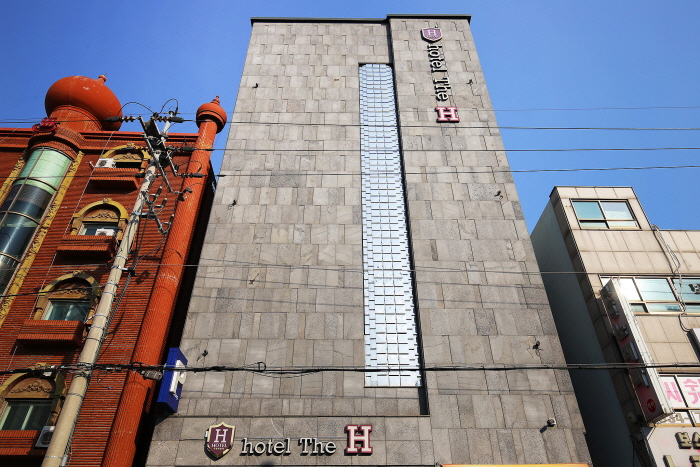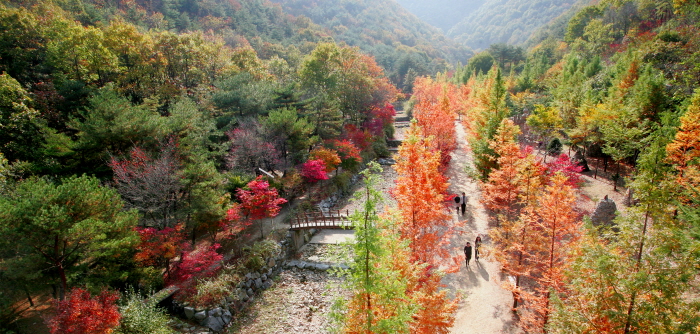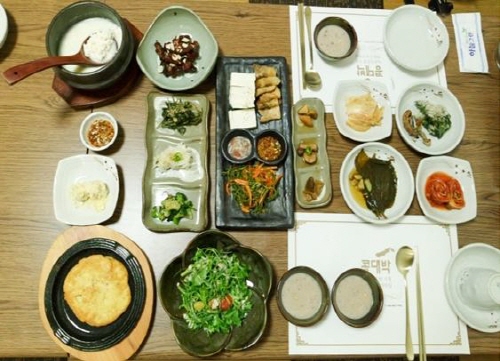Galbat Sikdang (갈밭식당)
15.6Km 2024-02-15
1553 Daecheonghosu-ro, Daedeok-gu, Daejeon
Galbat Sikdang, situated along the shores of Daecheonghosu Lake, specializes in freshwater fish cuisine. They offer maeuntang (spicy fish stew) featuring freshwater fish such as mandarin fish, eel, trout, and catfish, along with various types of sliced raw fish and grilled fish. Maeuntang is prepared with a secret homemade sauce and a variety of vegetables, specifically chosen to neutralize the fishy taste of the freshwater fish. Visitors can enjoy their meals while taking in the scenic views of Daecheongho Lake and its surroundings.
Hotel The H (호텔 더 에이치(Hotel The H))
15.6Km 2024-12-22
58 , Sintanjindong-ro 23beon-gil, Daedeok-gu, Daejeon
+82-42-932-0005
Hotel The H is a business hotel close to Sintanjin station in Daejeon, Chungcheongnam-do, offering quality services and reasonable prices. The pent rooms are equipped with barbecue, campfire, and cooking facilities, as well as a private terrace and swimming pool - making them ideal for parties and family gatherings. Some rooms are equipped with disabled toilets. Free breakfast is served at the 1st floor cafe, and there is a business center with shared PCs and printers. Geumgang Lohas Eco Park is a pleasant 20-minute walk away.
Yetteo Folk Museum (옛터민속박물관)
15.7Km 2025-02-04
321-35 Sannae-ro, Dong-gu, Daejeon
The Yetteo Folk Museum showcases traditional folk artifacts that reflect the daily life of the Daejeon region. Inside the exhibition hall, visitors can view items such as knives, tray tables, water droppers, cups, and oil lamps. The outdoor exhibition area features stone mortars, troughs, and grinding stones. The museum also includes a traditional jar exhibition hall, a Korean restaurant, and a traditional teahouse. Visitors can engage in hands-on experiences like natural dyeing, hanji paper crafts, and knot-making, or relax and enjoy a campfire.
Sangso-dong Forest Park (상소동 산림욕장)
16.1Km 2022-12-26
San 1-1, Sangso-dong, Dong-gu, Daejeon
+82-42-251-4771
Sangso-dong Forest Park is located at the point where the foothills of Maninsan Mountain and Sikjangsan Mountain meet. The road to the park is beautifully lined with sycamore trees. The park offers various facilities for enjoying nature and in particular, the stone pagodas placed throughout the park are a must-see. Visitors can stack their own rocks and make wishes relating to family, health, relationships, and more. The park is great for walks, hikes, or even just to relax as wild flowers bloom all throughout spring to fall.
Kong Daebak (콩대박)
16.5Km 2025-05-20
9 Daebak-gil, Geumnam-myeon, Sejong-si
Kong Daebak is a restaurant specializing in soybean-based dishes. There are two menu options: kongseobang bapsang and konggaksi bapsang. Kongseobang bapsang includes dishes like doenjang jjigae (soybean paste jjigae), salad, kong jeon (soybean pancake), suyuk (boiled pork slices), mushroom dishes, jangajji (pickled vegetable), and dessert. Adding dishes like kkaennip jeon (pan-fried battered perilla leaves) and dubu jeongol (bean curd hot pot) turns it into konggaksi bapsang. Since the food is prepared on the same day, advance reservations are essential.
Yeonsan Halmeoni Sundae (원조연산할머니순대)
16.8Km 2024-02-28
1525 Hwangsanbeol-ro, Yeonsan-myeon, Nonsan-si, Chungcheongnam-do
Yeonsan Halmeoni Sundae is a sundae specialty restaurant located near Yeonsan Market. It has been passed down for four generations, insisting on the traditional taste. The representative menu is sundae gukbap (sundae and rice soup), which puts sundae and various internal organs in a milky broth. The broth is made by boiling pork bones, and the sundae is handmade using only pure pork blood and green onions. They also offer a sundae jeopsi (assorted sundae) and ttaro gukbap (rice and soup).
Yahojeong (야호정)
16.8Km 2024-02-15
1869 Daecheonghosu-ro, Daedeok-gu, Daejeon
Yahojeong is a freshwater fish cuisine restaurant located near Daecheongho Lake. It offers jangeo gui (grilled eel) prepared with a special sauce and a refreshing maeuntang (spicy fish stew) made with mandarin fish, catfish, and shrimp. Situated in front of Daecheongho Lake, it allows diners to enjoy their meal accompanied by a beautiful lakeside view, making it a popular dining spot among locals.
Daecheongho Lake (대청호)
17.1Km 2022-12-26
Dong-gu, Daejeon / Munui-myeon, Chungcheongbuk-do
+82-42-251-4748
Daecheongho Lake is a man-made lake, stretching from Daejeon to Cheongju-si, Okcheon-gun, and Boeun-gun. Construction began in 1975 and finished in 1980, and the lake supplies water for various use to people in Daejeon and Cheongju.
The reservoir water spans an area of over 72.8 ㎢ with a perimeter of 80 kilometers, and the water kept in storage has a volume of 1.5 billion tons, making the reservoir the third largest lake in Korea. The area is famous for its beautiful driving course along a tree-lined road through the nearby mountain which has an altitude of 200 to 300 meters. Also, resident birds and migratory birds, such as white heron, can be seen during summer in the upper region of the lake.
Sejong Jeongwol Daeboreum National Kite-flying Contest (2025 세종시 정월대보름 전국 연날리기 대회)
17.4Km 2025-05-20
Sejong-dong, Sejong-si
+82-44-865-2411
Jeongwol Daeboreum, the Great Full Moon Festival, is celebrated on the 15th day of the first month of the lunar calendar. It is a traditional holiday celebrated with family, wishing for health and happiness. Visitors can create lifelong memories with traditional Korean games and programs. Visitors can also participate in the Jeongwol Daeboreum National Kite-flying Contest.
E-Mart - Sejong Branch [Tax Refund Shop] (이마트 세종)
17.4Km 2025-05-20
2F, 10, Docheong-ro, Yeongtong-gu, Suwon-si, Gyeonggi-do
-





![E-Mart - Sejong Branch [Tax Refund Shop] (이마트 세종)](http://tong.visitkorea.or.kr/cms/resource/70/2883170_image2_1.jpg)
 English
English
 한국어
한국어 日本語
日本語 中文(简体)
中文(简体) Deutsch
Deutsch Français
Français Español
Español Русский
Русский